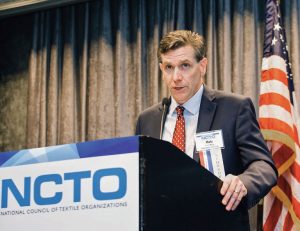
Outgoing Chairman Marty Moran outlined economic, employment and trade data; 2019 priority policies; and other NCTO activities during his “State of the U.S. Textile Industry” address during NCTO’s 16th annual meeting.
By Marty Moran
It has been an amazing year for the U.S. textile industry and the National Council of Textile Organizations (NCTO). President Trump’s pro-manufacturing agenda is forcing Washington to question longstanding norms, forcing the Washington establishment to rethink policies on trade, taxation, regulatory reform and a host of other issues.
The time for change is now and NCTO is committed to working with the Trump administration and our allies in Congress to achieve the best policy outcomes on these and other issues. But before laying out NCTO’s policy agenda, I want to recap how the industry fared in 2018.
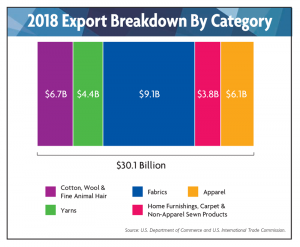 The Numbers
The Numbers
Thanks to its productivity, flexibility and innovation, the U.S. textile industry has cemented its position in the global market.
In 2018, the value of U.S. man-made fiber and filament, textile, and apparel shipments totaled an estimated $76.8 billion, this is an uptick from the $73 billion in output in 2017, and an increase of 12 percent since 2009.1
The breakdown of 2018 shipments by industry sector is:2
- $30 billion for yarns and fabrics;
- $27.4 billion for home furnishings, carpet & other non-apparel sewn products;
- $11.6 billion for apparel; and
- An estimated $7.7 billion for man-made fibers.
Capital expenditures also are healthy. Investment in fiber, yarn, fabric, and other non-apparel textile product manufacturing is up 79 percent from $960 million in 2009 to $1.7 billion in 2018.3
Our sector’s supply chain employs 594,147 workers.4 The 2018 figures include:
- 112,575 jobs in yarns and fabrics;
- 116,042 jobs in home furnishings, carpet, and other non-apparel sewn products;
- 112,692 jobs in apparel manufacturing;
- 25,100 jobs in man-made fibers;
- 126,553 jobs in cotton farming and related industry; and
- 101,186 jobs in wool growing and related industry.
As we examine these numbers, it is important to note that the heavy job losses incurred because of massive import surges in the 1995-2008 timeframe, virtually have stopped.5 Today, like most other U.S. manufacturing sectors, fluctuations in employment figures are generally due to normal business cycles, new investment, or productivity increases.
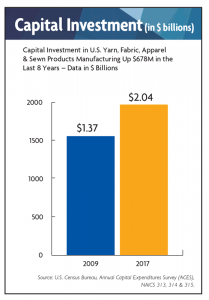 U.S. exports of fiber, yarns, fabrics, made-ups, and apparel were 30.1 billion in 2018.6 This is 5.4 percent increase in export performance over the $28.6 billion figure for 2017. Shipments to NAFTA and CAFTA-DR countries accounted for 47.5 percent of all U.S. textile supply chain exports.
U.S. exports of fiber, yarns, fabrics, made-ups, and apparel were 30.1 billion in 2018.6 This is 5.4 percent increase in export performance over the $28.6 billion figure for 2017. Shipments to NAFTA and CAFTA-DR countries accounted for 47.5 percent of all U.S. textile supply chain exports.
The breakdown of exports by sector is as follows:
- $6.7 billion – cotton and wool;
- $4.4 billion – yarns;
- $9.1 billion – fabrics;
- $3.8 billion – home furnishings, carpet & other non-apparel sewn products; and
- $6.1 billion – apparel.
The United States is especially well-positioned globally in fiber, yarn, fabric, and non-apparel sewn products markets; it was the world’s 2nd largest individual country exporter of those products in 2018.7
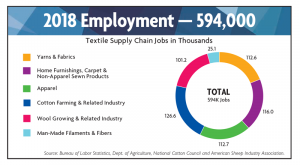 The most important U.S. export markets by region are:8
The most important U.S. export markets by region are:8
- $11.7 billion – USMCA;
- $3.5 billion – CAFTA-DR;
- $2.8 billion – Asia;;
- $2.7 billion – Europe;; and
- $2.8 billion – Rest of World.
Focusing solely on America’s $19.7 billion in manufactured fiber, yarn and fabric exports, the countries buying the most product are:9
- $4.4 billion – Mexico;
- $2.1 billion – Canada;
- $1.6 billion – China;
- $1.5 billion – Vietnam; and
- $1.4 billion – Honduras.
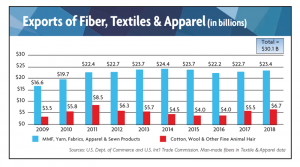 The numbers show that the fundamentals for the U.S. textile industry are sound. This is true even though some markets for U.S. textiles and apparel were soft last year. For the most part, any sluggishness was due to factors beyond control, such as disruption in the retail sector caused by the shifting of sales from brick-and-mortar outlets to the internet. With that said, the U.S. textile industry’s commitment to capital re-investment, and a continued emphasis on quality and innovation make it well-positioned to adapt to market changes and take advantage of opportunities as 2019 moves along.
The numbers show that the fundamentals for the U.S. textile industry are sound. This is true even though some markets for U.S. textiles and apparel were soft last year. For the most part, any sluggishness was due to factors beyond control, such as disruption in the retail sector caused by the shifting of sales from brick-and-mortar outlets to the internet. With that said, the U.S. textile industry’s commitment to capital re-investment, and a continued emphasis on quality and innovation make it well-positioned to adapt to market changes and take advantage of opportunities as 2019 moves along.
Policy Issues
For decades, U.S. policy systematically undervalued the importance of domestic manufacturing, and President Trump is right that this has hurt America.
Consequently, NCTO fully endorses President Trump’s macro policy objectives of reshoring industry, fighting for free, but fair trade, enforcing U.S. trade laws, making the U.S. tax code more competitive, buying American, cutting unnecessary regulation, revitalizing infrastructure, ensuring cheap energy, and fixing health care.
On trade, NCTO agrees with President Trump that U.S. trading relationships must be rooted in fairness and reciprocity to benefit a broad swath of American society.
America’s most important trading relationship is NAFTA, a pillar upon which the U.S.-Western Hemisphere textile supply chain is built. At $11.7 billion combined, Mexico and Canada are the U.S. textile industry’s largest export markets. Moreover, Mexico provides vital garment assembly capacity that the United States lacks at this time.
While strongly supporting the free-trade structure established under NAFTA, NCTO also firmly agreed with President Trump’s desire to improve the terms of the original agreement. Specifically, NCTO advocated for the following improvements as part of the NAFTA renewal negotiation:
- Maintain yarn forward as the fundament rule-of-origin for our sector;
- Eliminate tariff preference levels (TPLs) on apparel, non-apparel sewn products, fabrics & yarn;
- Require use of NAFTA-origin components beyond the “essential character” of the fabric, i.e. sewing thread, pocketing & narrow elastics;
- Strengthen buy American laws for Department of Homeland Security textiles & clothing by closing the Kissell Amendment loophole for Canada & Mexico; and
- Strengthen customs enforcement.
We are pleased that the majority of our stated objectives were accomplished in the agreement reached between the parties late last year under what has come to be known as the United States-Mexico-Canada Agreement (USMCA). Especially the fact that the basic yarn forward rule was preserved as the origin requirement for duty-free treatment.
In addition, the USMCA represents a demonstrative improvement for U.S. manufacturers of component parts such as thread, pocketing, narrow elastics, and coated fabrics. These items will have stronger origin requirements under the new agreement that will certainly boost sales to North American customers.
The USMCA will also close the Kissell loophole for Transportation Security Administration contracts. This new requirement will make it impossible for TSA prime contractors to replace U.S. textile inputs with competitive materials made in Mexico.
We are also pleased that enhanced customs enforcement language, specifically for textiles, was included as part of the new terms. This language will require various customs activities designed to address the unique challenges associated with textile-related customs fraud.
While the goal of complete elimination of the NAFTA TPL system was not achieved, the new agreement is better than the existing NAFTA in this area, also. A number of the NAFTA TPLs will experience a reduction from their current levels. Especially in the case of Canada, some of these reductions are sizable.
Finally, there is an important fundamental objective that was achieved with the finalization of an agreement between the three countries. When the United States first announced its intention to renegotiate NAFTA, there was overwhelming input from NCTO members that a dismantling of NAFTA, or a significant dilution of the yarn-forward rule of origin, would be disastrous. These fears were driven by the critical need to preserve the nearly $12 billion in current U.S. textile exports to our NAFTA partners. With the conclusion of a successful negotiation, these fears have now largely abated.
The achievement of these goals has led NCTO to formally endorse USMCA and to ask our congressional representatives to vote for its adoption this year.
The Trump administration’s Section 301 trade case against China’s intellectual property abuses is another issue that has seen a high degree of activity over the past year. In response to China’s trade-distorting practices, the United States has imposed penalty tariffs on three tranches, or groupings, of products to date targeting a total of $250 billion in U.S. imports from China. While NCTO is highly supportive of the initiation of a 301 case against China and we applaud the President for finally tackling China’s illegal trade practices, some products selected have negatively impacted our membership. Examples include dyes and chemicals used in the textile manufacturing process, which have resulted in increased production costs.
Overall, the vast majority of products identified for penalty tariffs in our sector have been inputs, and we think that a major opportunity is being missed by this approach. Throughout the process, NCTO has consistently pressed for a more precise and refined approach involving finished products as opposed to manufacturing inputs. Selecting finished goods, which generally contain 100-percent Chinese fiber, yarn and fabric components, would create benefits throughout the U.S. supply chain. Further, end items — specifically apparel and home furnishings — are the root of our sector’s problem with China. As a result, we feel that the targeting of finished products would dramatically improve the chances of bringing about serious reforms. NCTO will continue to make this case and engage heavily in the 301 process.
Beyond these issues, NCTO has already begun engagement with the Trump Administration in relation to its intention to negotiate new free trade agreements with the following:
- The European Union;
- The United Kingdom; and
- Japan.
We welcome the opportunity to gain greater access to these important overseas markets. Reducing tariff and non-tariff barriers will help put U.S. textile manufacturers on a much more even footing than we may currently enjoy with some these trading partners.
With that said, the rules for determining duty free privileges must be consistent with our existing free trade agreements. To that end, the United States government should insist on the following fundamental aspects in these negotiations:
- Establishment of a strong yarn forward rule of origin;
- Extended duty phase-outs, where warranted, for products deemed to be sensitive; and
- Inclusion of effective and separate customs textile enforcement language.
As for any new trade negotiations, beyond those announced by the Trump Administration, NCTO supports President Trump’s preference for individual bilateral free trade agreements (FTAs) over multilateral arrangements. Moreover, any new FTA targets should be limited to countries that trade in a fair, reciprocal manner. NCTO would oppose any FTAs with non-market economy countries like China and Vietnam because of the unfair advantages that producers in those countries derive from their state-run economies.
Beyond the actual negotiation of trade agreements, NCTO welcomes President Trump’s view that U.S. has made a mistake by not prioritizing trade enforcement in recent years.
As such, NCTO has worked to ensure that textiles be designated a Priority Trade Issue by Congress, recognizing the fact that textile and apparel shipments comprise more than 40 percent of all duties collected by Customs and Border Protection (CBP). Noting that the U.S. collected over $13 billion in textile and apparel tariffs in 2018, there exists tremendous incentive to circumvent customs laws in our sector.
Working with key members of Congress, such as Representative Patrick McHenry of North Carolina and former Representative Trey Gowdy of South Carolina, this past June a meeting with CBP Commissioner Kevin McAleenan was constructed to review textile enforcement activities. Follow-up meetings were also held CBP Executive Assistant Commissioner Brenda Smith, who toured a number of U.S. textile facilities in October of last year. NCTO’s intention as part of this initiative is to press CBP for an enhanced focus on our sector and the assignment of a greater level of resources to specifically address textile customs fraud.
Further, I am pleased that Assistant Commissioner Smith gave a presentation at our meeting yesterday. Her presentation helped to frame the steps that CBP intends to take in order to work more effectively with us as an industry toward improved customs enforcement.
Beyond the policy initiatives already discussed, there remain some additional items that will require our attention in 2019. They include the fact that the Miscellaneous Tariff Bill process will reengage later this year. The International Trade Commission will initiate a vetting process for the renewal of MTBs in October. NCTO members should be prepared to seek MTB treatment on inputs that are not available from a domestic source. Members should also be prepared to oppose MTB requests for items that would undermine your U.S. production and employment. Further, NCTO will be expressing opposition to the inclusion of finished products, noting that they distort the intended premise of providing duty relief on inputs that undergo further processing by U.S. manufacturers.
NCTO is also monitoring and is prepared to oppose various evolving initiatives that are designed to undercut the U.S. tariff structure. These include proposals such as:
- Granting duty relief under the Generalized System of Preferences for apparel;
- Expanding the use of Section 321 De Minimis duty breaks for importers; and
- Eliminating U.S. duties on high-performance outerwear.
With respect to government procurement policy, NCTO steadfastly supports the Berry Amendment. This “buy American” provision for the military is an example of how the government and private sector can work together for mutual benefit. The U.S. military gets a secure U.S. supply line for thousands of superior, highly-advanced products. In return, the domestic textile sector receives $1.5 to $2 billion in annual Defense Department sales that boost U.S. investment and employment.
NCTO is deeply concerned by congressional attacks on the Berry Amendment in recent annual defense bills, including the 2018 National Defense Authorization Act. NCTO urges Congress to reject any proposals to weaken the Berry Amendment, and instead work to strengthen the law.
NCTO also encourages Congress to include textiles in any efforts to enact commonsense laws or regulations that would strengthen “buy American” requirements applying to infrastructure or other federal spending. As demonstrated by Berry, when the federal government buys “American,” it is good for the U.S. textile industry and even better for America.
NCTO urges Congress to follow President Trump’s lead by drafting and passing a comprehensive plan to rebuild America’s infrastructure. Besides boosting U.S. productivity and facilitating commerce, infrastructure is a key market for textile products such as workwear, geosynthetics, and filtration systems.
Fostering a national culture of innovation is also important. NCTO urges continued support for the Advanced Functional Fabrics of America (AFFOA). This Defense Department-funded program is matched three to one with private dollars, and tasked with making it easier to develop and commercialize the next generation of high-performance textiles.
NCTO also calls for the U.S. government to invest in improving automation for garment assembly. This technology shows promising potential to reshore U.S. textile and apparel production and jobs.
Another NCTO priority is ensuring that the U.S. textile industry has uninterrupted access to reasonably priced energy. This is certainly critical to power our facilities in a cost effective and globally competitive fashion. In addition, most man-made fibers are derivatives of petroleum products and many textile producers are reliant on natural gas to power manufacturing operations. Noting this, NCTO supports construction of expanded oil and gas pipeline capacity to keep energy prices low.
Finally, the U.S. textile industry must acknowledge its workforce is aging, making the recruitment of new talent a priority. U.S. companies must continue to forge links with local and state leaders, and educators to make sure government policy nurtures a labor pool both adequate in size and well prepared to succeed in a competitive global economy.
Other NCTO Activities
There were also matters of focus beyond strict policy issues. One year ago, we initiated a merger with the American Fiber Manufacturers Association (AFMA), a fellow trade association representing domestic manufacturers of man-made fiber. I am pleased to report that the merger has been highly successful.
From NCTO’s perspective, the merger with AFMA helped to add new members, financial resources and extend NCTO’s political reach. It also solidified NCTO’s status as the policy voice of every facet of the U.S. textile production chain.
From the perspective of former AFMA members, the merger has preserved a seat at the federal policy table for the multi-billion dollar U.S. man-made fiber sector.
In terms of membership recruitment as a whole, NCTO enjoyed a superlative year. A total of 22 new companies joined NCTO’s membership rolls for the first time. An additional three companies, who were not members in our most recent fiscal year, rejoined NCTO’s membership.
This past year we also continued NCTO’s American Textiles: We Make Amazing™ campaign, which is helping to rebrand the U.S. textile sector’s image. America’s textile industry is world class thanks to leveraging the most cutting-edge production processes, investing in the best machinery, and leading in sustainability and innovation. Our We make Amazing campaign is intent on making sure that policy makers and members of the press have an accurate and positive understanding of the modern U.S. textile industry.
Campaign highlights include:
- Launching a new website to promote the U.S. textile industry, Textiles in the News (TIN), textilesinthenews.org, this site is a platform to drive policymakers and opinion leaders to content that rebrands the U.S. textile industry along the American Textiles: We Make Amazing message;
- Publishing a fourth edition of Textures, NCTO’s member magazine;
- Emailing a weekly news blog, also called Textiles in the News;
- Publishing the quarterly NCTO Newsletter;
- Posting planned social media on Twitter, Facebook, LinkedIn, and Instagram;
- Regular public relations outreach to selected media; and
- Generating more than $2 million in earned media coverage.
Judging by the engagement generated by American Textiles: We Make Amazing marketing efforts, more and more people are getting an accurate, positive description of our sector, and as a result, are viewing the U.S. textile industry in a new light.
Conclusion
Although the U.S. textile industry is world-class, it cannot afford to rest. There will always be intense and sometimes unfair competition from abroad, changing consumer demands and inevitable economic downturns.
As I have outlined, NCTO is involved in the policymaking process on all major matters affecting the entire textile production chain. This includes key international trade negotiations, congressional initiatives, federal procurement, and regulatory activity. However, good policy does not materialize from thin air, and NCTO must have the financial and political resources necessary to help build a stable and prosperous future for U.S. textile companies.
In order to remain effective, NCTO must maintain the broadest possible membership. Doing so expands and strengthens our political footprint. Just as important, however, is the need for our members to actively engage with Washington policy makers. There is no stronger or more accurate voice for sound economic and manufacturing policy than those who have invested their careers in the U.S. manufacturing sector.
My year as chairman of NCTO has taught me that there are thousands of interest groups and entities seeking a choice position at the federal policy table. If we do not aggressively defend our business interests, those with a different and often adverse agenda will gladly push our industry to the side. For the sake of our investments, our workers, and the communities that are so dependent on our continued viability, that is simply not an acceptable outcome.
Fortunately, the Trump administration wants to spur manufacturing output and jobs. It is incumbent upon the U.S. textile industry to seize this generational opportunity to usher in a new era of growth. With so much at stake, I implore all members of NCTO to stay active in this indispensable association that is fighting to promote the interest of our industry here in Washington.
Thank you for the opportunity to be Chairman of NCTO for this past year. It has been a privilege to serve this great industry.
Sources:
1: U.S. Census Bureau Manufacturers’ Shipments, Inventories, and Orders. Data covers NAICS categories 313 (Textile Mills), 314 (Textile Product Mills), 315 (Apparel), and 32522 (Artificial and Synthetic Fibers and Filaments). 2018 Data for NAICS 32522 is not yet available. Our 2018 estimate for the value of shipments in that category is $7.7 billion.
2: U.S. Census Bureau Manufacturers’ Shipments, Inventories, and Orders. Data covers NAICS categories 313 (Textile Mills), 314 (Textile Product Mills), 315 (Apparel), and 32522 (Artificial and Synthetic Fibers and Filaments). 2018 Data for NAICS 32522 is not yet available. Our 2018 estimate for the value of shipments in that category is $7.7 billion.
3: U.S. Census Bureau, Annual Capital Expenses Survey (ACES). Data covers NAICS categories 313 (Textile Mills) and 314 (Textile Product Mills).
4: U.S. Bureau of Labor Statistics, U.S. Department of Agriculture, National Cotton Council, and the American Sheep Industry Association.
5: U.S. Bureau of Labor Statistics
6: Data for textiles and apparel is from The Export Market Report produced by the U.S. Department of Commerce, Office of Textiles and Apparel (OTEXA). U.S. export data for cotton, wool, and fine animal hair is calculated from the U.S. International Trade Commission Interactive Tariff and Trade DataWeb using HTS Codes 5101, 5102, 5103 (wool), 5201, 5202, and 5203 (cotton).
7: U.N. COMTRADE Database, HTS Chapters 50-60
8: U.S. Commerce Department and U.S. International Trade Commission
9: Id.
Editor’s Notes: Marty Moran is CEO of Jefferson, Ga.- based Buhler Quality Yarns Corp. He served as the 2018-2019 NCTO chairman. At the annual meeting in Washington, Leib Oehmig, president and CEO of Glen Raven, N.C.-based Glen Raven Inc. succeeded Moran as NCTO chairman for 2019-20 (See “Executive Forum,” TW, this issue).
The North American Industry Classification System (NAICS) is the standard used by Federal statistical agencies in classifying business establishments for the purpose of collecting, analyzing, and publishing statistical data related to the U.S. business economy. NAICS Subsector 313 covers Textile Mills, subsector 314 covers Textile Product Mills and subsector 315 covers Apparel.
May/June 2019




